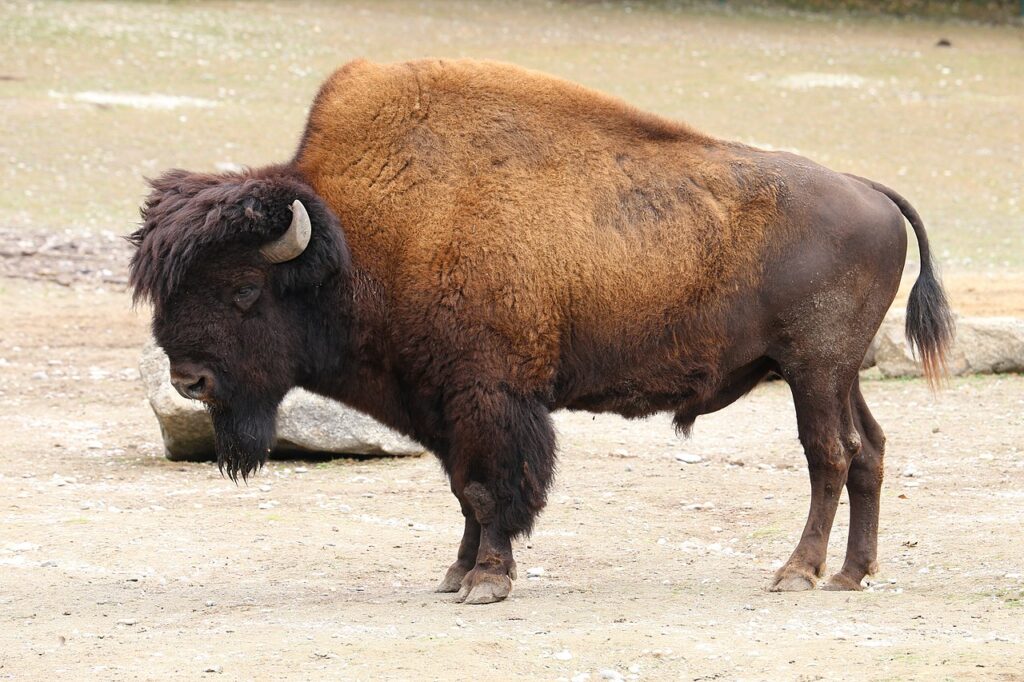The American bison, also known as the buffalo, is an iconic symbol of the Native American tribes, who have long relied on the animal for food, clothing, and other resources. However, the species was nearly hunted to extinction in the 19th century, with fewer than 1000 individuals remaining in the wild by the late 1800s. Today, thanks to conservation efforts, the American bison has made a remarkable comeback, but challenges still remain in restoring this species to its natural habitat.
Bison are also an important part of the history and mythology of the American West, and have been featured in many works of art and literature over the years.
Bison are important ecological engineers, playing a vital role in maintaining the health and diversity of grassland ecosystems. Their grazing helps to stimulate new plant growth and create habitats for a wide range of other species, from prairie dogs to grassland birds.

Physical Characteristics
The American bison is a large, powerful animal, with bulls weighing up to 2000 pounds and standing up to six feet tall at the shoulder. They have a distinctive shaggy coat of fur, with a large hump on their shoulders and a long beard. Bison have a broad, muscular build, with short, curved horns and sharp hooves. They are well adapted to life on the open plains, with a keen sense of smell and excellent hearing and eyesight, which helps them to detect predators and avoid danger. They are also strong swimmers and can cross rivers and streams when necessary.
Bison are social animals and live in herds, which can range in size from a few dozen to several hundred individuals. The herds are usually made up of females and their young, with males living on their own or in small bachelor groups.
Bisons have a unique digestive system that allows them to extract nutrients from tough, fibrous grasses. They have a four-chambered stomach and can regurgitate and rechew their food to help break it down more effectively.
The Historic Range of the American Bison
The American bison was once found in great numbers across the Great Plains and the Western United States, with estimates suggesting there were once as many as 60 million individuals roaming the continent. However, the arrival of European settlers in the 19th century brought about a rapid decline in bison populations. Bison were hunted for their meat and hides, with the introduction of firearms making it easy for hunters to kill large numbers of animals quickly.
By the late 1800s, bison populations had declined to fewer than 1000 individuals in the wild. The species was on the brink of extinction, with most of the remaining animals confined to small pockets of land, such as Yellowstone National Park.
How is the American Bison being conserved?
Conservation efforts to restore the American bison have been ongoing for over a century. In the late 19th and early 20th centuries, a handful of ranchers and conservationists began breeding bison in captivity in an effort to restore wild populations. Bison were also reintroduced to protected areas, such as national parks and wildlife refuges, where they could live and breed in safety.
Today, there are an estimated 350,000 bison in the United States, with populations found in national parks, wildlife refuges, and on private ranches. Bison are also being reintroduced to areas where they were once found in the wild, such as Montana’s Fort Peck Reservation and the Great Plains of Kansas and Nebraska.
Challenges ahead for the American Bison
While the restoration of the American bison is a remarkable success story, challenges still remain. One of the biggest challenges facing bison conservation is habitat loss. As human populations continue to grow and expand into previously undeveloped areas, bison are losing the open grasslands and prairies that are essential to their survival.
Another challenge is genetic diversity. Due to the small number of bison remaining in the wild in the late 1800s, the genetic diversity of the species was greatly reduced. Inbreeding can lead to reduced fertility and other health problems, making it essential to maintain genetic diversity in bison populations.
Finally, bison conservation also faces challenges from disease and predation. Bison can be susceptible to diseases such as brucellosis, which can spread to domestic cattle and other wildlife. Predation from wolves and other predators can also be a concern, particularly in areas where bison are being reintroduced to the wild.
Conclusion
The American bison is a remarkable species, with a long and storied history in the American West. While the species was nearly driven to extinction in the 19th century, conservation efforts have helped to bring the bison back from the brink. However, challenges still remain in restoring bison to their natural habitat, and ongoing conservation efforts will be essential to ensure that this iconic species continues to thrive for generations to come
Help us Help Them! Think Wildlife Foundation is a non profit organization with various conservation initiatives. Our most prominent campaign is our Caring for Pari intiative. Pari is a rehabilitated elephant at the Wildlife SoS Hospital. 25% of the profits from our store are donated to the elephant hospital for Pari. Other than buying our wonderful merchandise, you could donate directly to our Caring For Pari fundraiser.
Written by: Sanghmitra Singh
